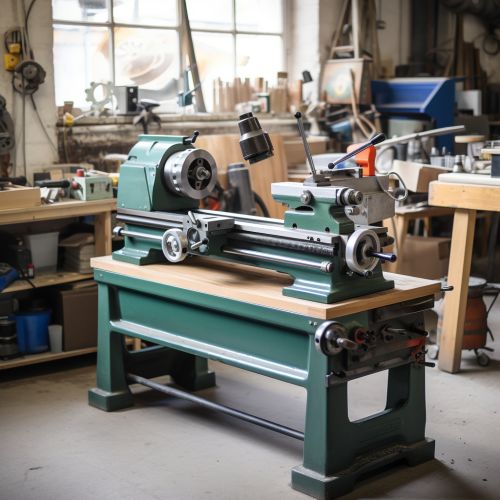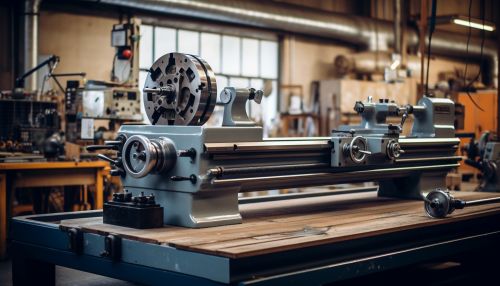Lathe
Introduction
A lathe is a machine tool that rotates a workpiece about an axis of rotation to perform various operations such as cutting, sanding, knurling, drilling, deformation, facing, and turning, with tools that are applied to the workpiece to create an object with symmetry about that axis.


History
The lathe is an ancient tool, dating at least to the Egyptians and known and used in Assyria, Greece, the Roman and Byzantine Empires. The origin of turning dates to around 1300 BCE when the Ancient Egyptians first developed a two-person lathe. One person would turn the wood workpiece with a rope while the other used a sharp tool to cut shapes in the wood.
Types of Lathes
There are many types of lathes, each designed for specific applications. Some of the most common types include:
- Engine Lathe: The engine lathe is the most widely used type of lathe and is commonly found in workshops. It is a versatile machine that can perform a variety of operations.
- Turret Lathe: A turret lathe is a type of metalworking lathe that is used for repetitive production of duplicate parts.
- Toolroom Lathe: A toolroom lathe is a lathe that is designed for high precision work.
- CNC Lathe: A CNC lathe is a computer-controlled version of the engine lathe. The CNC lathe is controlled by a computer, which allows for the automation of the manufacturing process.
Components of a Lathe
A lathe consists of several components, each of which plays a crucial role in its operation. These components include:
- Bed: The bed is the base of the lathe that supports all other parts of the machine.
- Headstock: The headstock houses the main spindle and the change gears.
- Tailstock: The tailstock is used to support the end of the workpiece.
- Carriage: The carriage holds the cutting tool and moves it longitudinally or perpendicularly to the workpiece.
- Lead Screw: The lead screw is used to move the carriage automatically during threading.
- Feed Rod: The feed rod is used for automatic feed of the carriage.
Operation of a Lathe
The operation of a lathe involves several steps, including:
1. Mounting the Workpiece: The workpiece is clamped in the chuck or between the centers.
2. Setting the Speed: The speed of the lathe is set using the speed control mechanism.
3. Applying the Tool: The tool is applied to the workpiece at the desired location.
4. Performing the Operation: The lathe is then started and the tool is moved along the workpiece, removing material in the process.
Applications of Lathes
Lathes are used in a wide variety of applications, ranging from small hobbyist workshops to large industrial production facilities. Some of the most common applications include:
- Metalworking: Lathes are commonly used in metalworking to perform operations such as turning, boring, and threading.
- Woodworking: In woodworking, lathes are used to create intricate designs and shapes.
- Glass Working: Lathes are also used in glass working to create a variety of glass objects.
- Pottery: Lathes are used in pottery to shape the clay into various forms.
Safety Considerations
Operating a lathe can be dangerous if proper safety precautions are not taken. Some of the most important safety considerations include:
- Always wear safety glasses when operating a lathe.
- Never reach over the lathe while it is in operation.
- Always check the machine for any damage before use.
- Never leave the machine unattended while it is in operation.
